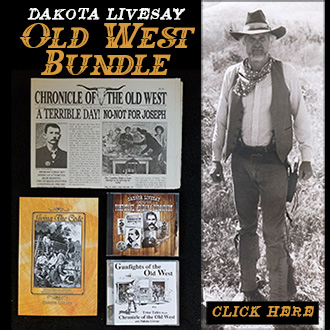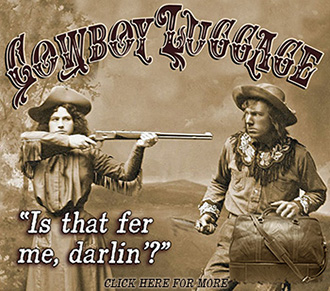At the ripe old age of sixteen, Texan Bud Frazer joined the Texas Rangers. Ten years later he was elected the sheriff of Reeves County.
 One of his deputies was a man named Jim Miller. Miller is considered by some historians to be the deadliest gunman of the Old West. He was a dapper little man who was quiet and never cussed. Yet he usually operated as a hired gun killing nameless men who were buried in unmarked graves.
One of his deputies was a man named Jim Miller. Miller is considered by some historians to be the deadliest gunman of the Old West. He was a dapper little man who was quiet and never cussed. Yet he usually operated as a hired gun killing nameless men who were buried in unmarked graves.
It seems that while a deputy under Frazer, Miller shot a Mexican prisoner. Supposedly the prisoner had information about Miller stealing a couple of mules. Sheriff Frazer fired Miller. Later Miller was appointed the city marshal of Pecos, Texas. A feud between Frazer and Miller went on for about two years when on April 12, 1894 the two men engaged in a shootout. In the process Frazer shot Miller in the arm, and unloaded his pistol in Miller’s chest. Miraculously, Miller survived.
Eight months later the two men met again. This time Frazer shot Miller in the right arm and left leg. Frazer then shot Miller two more times in the chest. But Miller didn’t go down, and Frazer ran off in confusion.
Bud Frazer began wondering what it would take to kill this man. After all he had shot him at least a half dozen time in the chest. Then Frazer discovered the reason Miller survived the shootings. Both times he was wearing a steel breastplate.
 Two years later the two men met a third time. This time Jim Miller got off the first shot… a shotgun blast to Bud Frazer’s face. I guess Miller was concerned that Frazer might have started wearing a breastplate.
Two years later the two men met a third time. This time Jim Miller got off the first shot… a shotgun blast to Bud Frazer’s face. I guess Miller was concerned that Frazer might have started wearing a breastplate.
At the ripe old age of sixteen, Texan Bud Frazer joined the Texas Rangers. Ten years later he was elected the sheriff of Reeves County.
One of his deputies was a man named Jim Miller. Miller is considered by some historians to be the deadliest gunman of the Old West. He was a dapper little man who was quiet and never cussed. Yet he usually operated as a hired gun killing nameless men who were buried in unmarked graves.
It seems that while a deputy under Frazer, Miller shot a Mexican prisoner. Supposedly the prisoner had information about Miller stealing a couple of mules. Sheriff Frazer fired Miller. Later Miller was appointed the city marshal of Pecos, Texas. A feud between Frazer and Miller went on for about two years when on April 12, 1894 the two men engaged in a shootout. In the process Frazer shot Miller in the arm, and unloaded his pistol in Miller’s chest. Miraculously, Miller survived.
Eight months later the two men met again. This time Frazer shot Miller in the right arm and left leg. Frazer then shot Miller two more times in the chest. But Miller didn’t go down, and Frazer ran off in confusion.
Bud Frazer began wondering what it would take to kill this man. After all he had shot him at least a half dozen time in the chest. Then Frazer discovered the reason Miller survived the shootings. Both times he was wearing a steel breastplate.
Two years later the two men met a third time. This time Jim Miller got off the first shot… a shotgun blast to Bud Frazer’s face. I guess Miller was concerned that Frazer might have started wearing a breastplate.
February 5, 2017 | Categories: Old West Myth & Fact | Leave A Comment »
In 1822 William Ashley advertised for men to go up the Missouri River and trap for pelts. The trappers were to spend the winter alone, and then Ashley would come back up river in keelboats, the next spring, and pick them up along with the furs.
When Ashley arrived the next spring, on May 29, 1823, he was met by Jedediah Smith, and was told the trappers needed horses. On May 31 Ashley and his men went to a nearby Arikara Indian village in order to trade for the needed horses.
The next day Ashley got 20 horses from the Arikara in return for gun powder and shot… a trade they were later to regret. In the middle of the fourth night there, one of two men who were staying in the Indian’s village came running out screaming that his partner had been killed. It’s not known if it was part of a plan or there had been a problem, but at the break of dawn the air was filled with arrows and just traded bullets, fired from behind the stockade. The horses were the first to die. Using the dead horses as shelter, the mountain men yelled for the boats to come ashore and pick them up.
Finally, Ashley was able to get a couple of skiffs up to the shore. It was every man for himself. Those who didn’t make it in a skiff were washed downriver. Finally, with the survivors aboard the keelboats, they drifted downriver about 25 miles before they pulled ashore to take inventory.
There were 13 men dead or missing. Eleven were wounded. Their horses were dead, and they had provided the local Indians with enough fire power to keep them out of the area for some time.
December 5, 2016 | Categories: Old West Myth & Fact | Leave A Comment »
 Six months after a member of his own gang shot Jesse James in the back, and after committing at least twenty robberies, on October 5, 1882, Frank James, Jesse’s brother surrendered to Missouri governor Thomas Crittenden.
Six months after a member of his own gang shot Jesse James in the back, and after committing at least twenty robberies, on October 5, 1882, Frank James, Jesse’s brother surrendered to Missouri governor Thomas Crittenden.
At the ceremonial surrender, Frank James said, “I want to hand over to you that which no living man except myself has been permitted to touch since 1861, and to say that I am your prisoner.” With that Frank James turned over his .44 Remington revolver, holster and cartridge belt.
Now, prior to this Frank James had entered into negotiations that were to determine the outcome of his surrender and later trial. He had written Governor Crittenden asking for amnesty because the hardships he had endured as an outlaw were worse than a prison sentence. He also maintained that others committed many of the crimes of which he had been accused.

Governor Crittenden had replied that he could not give amnesty… but if Frank James went on trial and was convicted, he could give him a pardon.
So Frank James went on trial for murdering Frank McMillan, a passenger who had been killed during a train robbery a year earlier. After seven days of witnesses, and two days of legal arguments, Frank was acquitted. It seems the case against him had mysteriously collapsed.
After his acquittal, Frank James returned to a normal life and spent 32 years in a variety of jobs, including a four-year tour with a theater company, and six years as a doorman at a St. Louis burlesque house. His last years were spent on the Missouri homestead where he grew up, charging tourists 50 cents to view the cabin in which he and his brother were born.
November 29, 2016 | Categories: Old West Myth & Fact | Leave A Comment »
 In 1874, Jesse and Frank James were robbing banks and trains to the point that the railroads decided to hire the famous detective group the Pinkertons to hunt them down. But, the Pinkertons, in spite of their numbers and skill, weren’t having any luck rounding up the James boys. Then late in 1874 one of their agents, John Wicher was found dead close to the James home. The Pinkertons were convinced that the James’ or one of their people had killed him, and they decided to raise the ante.
In 1874, Jesse and Frank James were robbing banks and trains to the point that the railroads decided to hire the famous detective group the Pinkertons to hunt them down. But, the Pinkertons, in spite of their numbers and skill, weren’t having any luck rounding up the James boys. Then late in 1874 one of their agents, John Wicher was found dead close to the James home. The Pinkertons were convinced that the James’ or one of their people had killed him, and they decided to raise the ante.
Receiving information that Jesse and Frank were visiting their mother in Kearney, Missouri, on January 26, 1875, the Pinkertons surrounded the James home with the idea of catching Jesse and Frank. In the process, they threw an incendiary device into the house to illuminate the interior. But it exploded. Unfortunately, it blew off the arm of Jesse and Frank’s mother and killed their little brother. In addition to this, neither Jesse nor Frank was there.
Although the Pinkerstons never acknowledged that they were responsible for the bombing, everyone knew they did it. Realizing they had overplayed their hand, from this point forward the Pinkertons developed a low profile in their search for the James Brothers.
The bombing convinced everyone that the James Brothers were innocent victims of the powerful railroads. The Missouri legislature even came close to passing a bill that would give amnesty to the Jameses. And Zerelda Samuel, their mother, was always willing to make public appearances, showing her missing arm, and giving a melodramatic speech about how the evil railroads were persecuting her innocent sons.
It worked too. Because farmers throughout the region hid and protected the James Brothers, so the Pinkertons were never able to come close to catching them.
October 18, 2016 | Categories: Old West Myth & Fact | Leave A Comment »
Little is known of William Arnett prior to his arriving with a couple of buddies in Goldcreek, Montana on August 21, 1862. The trio had a string of six good horses. However, there was something strange about the men. Although they looked as if they had done some hard traveling, they had no saddlebags or other evidence of men who would own fine horseflesh.
The men put the horses in a local corral and put out the word that they were for sale. In a short time, they found a buyer. The three men split up the proceeds from the sale, and Arnett’s buddies left town. But William Arnett decided to stick around Goldcreek, have a few drinks and play some cards.
On August 25, two strangers arrived from Elk City, Idaho. They started asking around town if three men had come through with a half dozen horses. They said the men had stolen the horses. The strangers were told three men had come through town, sold the horses, and one was still in town, at the saloon.
The men went to the saloon and found Arnett playing cards. When they confronted Arnett, he said he wasn’t going to surrender and end up being hanged… That he would rather shoot it out right now. With his cards in one hand, Arnett went for his gun. Unfortunately, for him, the two men shot faster than Arnett, and killed him on the spot.
When the smoke cleared, Arnett was laying on the floor, cards still clutched in one hand and gun in the other. In fact, his hands clutched the cards and gun so tightly they couldn’t be pried open, and William Arnett was buried with two full hands.
October 3, 2016 | Categories: Old West Myth & Fact | Leave A Comment »
As a teenager Dick Barter and two of his relatives went to the California goldfields to seek their wealth. Dick’s relatives found working a sluice box too tough and went up to Oregon. But Dick loved the possibility of becoming wealthy.
One of the richest areas was Rattlesnake Bar. Dick worked that area. He constantly told everyone how beautiful the area was and that Rattlesnake Bar would make him wealthy. So, people started calling him Rattlesnake Dick.
But it seems his personality was such that he irritated everyone around him. After working the area a couple of years, some cattle showed up missing. Although there was no proof, Rattlesnake was accused and arrested for stealing the cattle. Eventually he was found innocent. A few months later he was accused and arrested for stealing a mule. This time he was convicted. But, on his way to prison, another man confessed to the crime.
Dick decided he had no future at Rattlesnake Bar, so he left. For two years he prospected with no incidents. Then miner’s items started disappearing, and Dick was again accused of taking them. To complicate things, a miner who had known Dick at Rattlesnake Bar told everyone about Dick’s background.
At this point Rattlesnake Dick decided that if everyone thought he was a thief, that’s just what he would become. And for the next three years he and his gang stole cattle and horses, robbed miners and stages.
Then on July 24, 1859 he met the fate of most outlaws and was killed by the sheriff. One could say, Rattlesnake Dick lived down to the expectations of others.
September 17, 2016 | Categories: Old West Myth & Fact | Leave A Comment »
Following the money, in 1851 professional gambler Charles Cora traveled to San Francisco. He brought with him his 22-year-old paramour, Bella.
Gambling being legal, and Charles being a good gambler, he did well. But, San Francisco’s high society looked down upon them because he and Bella weren’t married.
In November of 1855 Charles and Bella went to a play at the American Theater. Their attendance outraged many of the attendees, including Marshall Richardson and his wife. Marshall Richardson asked them to leave. But Charles and Bella refused.
Over the next couple of days Charles and the Marshall exchanged insults, until one evening a drunken Marshall Richardson called Charles out. Shots were fired, and Marshall Richardson was dead.
In the first trial of Charles, the jury failed to come to a decision. So a second trial was scheduled. Charles Cora was confident of an acquittal… That is until May 14 when James Casey joined him in jail.
James Casey had shot James King, a respected newspaper editor. Ten thousand people gathered outside the jail, seeking vengeance for the shooting of King. Finally, the sheriff handed Casey over to the vigilantes. But they weren’t satisfied. They also wanted Charles Cora.
For two days Cora and Casey were held by the vigilantes. When the newspaper editor died, Cora and Casey’s fate was sealed. On May 22, as the editor was buried, Cora and King were hanged.
Had Casey not killed the editor, Cora would have probably gotten off with a second trial. But that’s not the only point of irony. Just before Cora was hanged, he and Bella got married. Had they done this nine months earlier, Cora wouldn’t have even been in jail.
June 2, 2016 | Categories: Old West Myth & Fact | Leave A Comment »
As a young man Bill Miner tried his hand at mining gold in California and later had a mail delivery service in San Diego. Not doing well at either, he started looking for some easy money. So… Bill robbed his first stage. Not being a success at this either, he was arrested and sentenced to 15 years in San Quentin. While in San Quentin Bill Miner “got religion” and was released after serving 10 years.
Moving to Colorado, Bill left California and his religion behind. He robbed a number of trains and stagecoaches until he was captured and imprisoned. A jailbreak was followed by more robberies and another arrest. This time he was sentenced to a 25-year term in San Quentin. Again Bill Miner got religion and was released after serving 10 years.
A trip to Georgia for contributions from various trains and banks got him arrested again. This time he was sentenced to a life term.The religion ploy having run its course, Bill went back to the escape route. But he wasn’t any more successful with this activity than any other in which he engaged. He tried escaping three times, only to be captured and brought back to prison. Finally, in 1913, Bill Miner died in his cell.
Now, the phrase that Bill Miner coined that is used today took place on March 18, 1881. During a stagecoach robbery Bill made sure the passengers couldn’t go for their guns by telling them “hands up.” This was the first time this phrase was used. Later robbers varied the phrase by telling their victims, “hold your hands up” which later identified their activity as a “hold up.”
May 4, 2016 | Categories: Old West Myth & Fact | Leave A Comment »
Anton Veith was a Milwaukee newspaper editor traveling out West. On August 15, 1900, he was on a stage on its way to Yosemite. Carrying on idle conversation with fellow passengers, Anton asked them what they would do in the case of a holdup, and they had their entire fortune on them. One said he would give it up; he could make another fortune, but didn’t have another life. Another said that a bullet didn’t always hit its mark, and he would run the other way.
A little later that day the stage pulled to a stop, and Anton heard a voice say, “Get Down!” It was a holdup. The robber had a gun slung over his shoulder, and a pistol in his hand. No one on the stage had a gun, not even the driver and guard. Anton said the robber was careless, and on several instances, he felt he could jump him, but no one else was willing to help.
The robber was kind to the women, allowing them to stay in the stage. And most of the men were able to hide some of their money and valuables. The robber even gave Anton back his heirloom pocket watch.
Anton had his camera with him, and he brazenly asked the robber if he could take a picture of the robbery in progress. Amazingly, the robber agreed. The picture Anton took shows the robber, gun in hand, and the male passengers all in a line. Following the picture, the robber had everyone load up and told the stage to drive off.
A copy of the picture was turned over to the legal authorities. But, despite the picture, and an extensive hunt for the robber, as happens many times today, he was never found.
April 14, 2016 | Categories: Old West Myth & Fact | Leave A Comment »
Harvey Gleason was over six feet tall. He had a shabby beard, ruddy face with flaming red hair and black eyes. By his mid 40s, he had supposedly killed several soldiers and deputy marshals.
But, people didn’t know him as Harvey Gleason, everyone knew him as Teton Jackson. He got his name from his favorite area, the Teton Mountains. For a living Teton Jackson stole horses… Not one or two at a time, but hundreds. For about eight years, Teton and his men stole horses during the summer and hid out among the Teton Mountains during the winter.
While in Eagle Rock, Idaho, Teton killed a man. When the sheriff came to investigate the shooting, he found the victim frozen stiff on the ground. Needing evidence of the killing, and unable to transport the whole body, the sheriff brought in just the head.
Finally, livestock associations in Idaho and Wyoming started putting up rewards for Teton. And, money talked. A sheriff found Teton, and brought him in. He was tried and on November 5, 1885, sentenced to 14 years in prison. Everyone breathed a sigh of relief. But, relief was short lived. For nine months later, Teton escaped from jail. Even though Teton was free for two years before he was recaptured, few horses were stolen because his gang’s numbers were drastically reduced by posse bullets and jail.
After four years in jail, Teton received a pardon for good behavior. He continued that good behavior for the next 35 years, marring a Shoshone woman, and doing some guiding, always riding a horse with his brand on it.
February 25, 2016 | Categories: Old West Myth & Fact | Leave A Comment »
Levi Richardson was a buffalo hunter who, because of the lack of buffalo, had become a freighter. He was a well-liked, hard working individual who was known for his proficiency with a pistol and rifle… As well as a quick temper.
Frank Loving, also known as “Cock-eyed” Frank because his eyes tended to look toward each other, was an ex-cowboy turned gambler. Loving, unlike Richardson, was known to be cool, with a steady nerve. Both men were spending some time in Dodge City, Kansas.
Now comes the catalyst… a woman. It seems that Levi Richardson fell in love with a young woman. Unfortunately, for him, she loved another. And, that person was none other than Cock-eyed Frank Loving.
It was about 8:00 Saturday evening, April 5, 1879. Richardson was warming himself at the potbelly stove in the Long Branch Saloon, when Loving came in and took a seat at one of the gambling tables. Richardson followed him to the table. A few, less than genteel, words were exchanged. With both men standing face to face, Richardson went for his gun. He pulled off a shot as Loving was drawing his pistol. Loving’s first shot misfired. Seeking cover, Loving ran behind the potbelly stove. But Richardson was right behind him taking two more shots.
Fortunately, for Loving, after that first misfire, his gun performed flawlessly. Using cool deliberation, Loving shot Richardson in the chest, side and arm. He died on the spot. Loving, on the other hand, suffered only a scratch on the hand. After the smoke settled, both guns were checked. In the fracas, both men had emptied them. The amazing thing about the gunfight was that with lead flying everywhere in a crowded room, no bystander was hit.
February 18, 2016 | Categories: Old West Myth & Fact | Leave A Comment »
 Born in England, Alice Ivers was educated in a female seminary. She came to the United States and eventually settled down in Colorado where she married Frank Duffield, a mining engineer.
Born in England, Alice Ivers was educated in a female seminary. She came to the United States and eventually settled down in Colorado where she married Frank Duffield, a mining engineer.
Frank enjoyed playing poker, and Alice went with him and watched. Sometimes, when Frank was at work, Alice would sit in on games. When her husband was killed in a mine explosion Alice turned to cards full time. She did so well that soon the miners were calling her “Poker Alice.”
In Silver City, New Mexico she “broke the bank.” Feeling flush, she headed to New York and proceeded to spend it all.
She returned to Colorado and worked for Bob Ford, the person who shot Jessie James… That is, until Ed Kelly killed him.
Poker Alice always dressed like a lady; even though she was constantly puffing on a cigar. Like most gamblers, Alice carried a pistol, and she wasn’t afraid to use it either. One night a drunken miner pulled a knife on the dealer at the next table. Alice shot the miner. Poker Alice ended up marrying the man whose life she saved. Later, when she owned her own establishment, she shot and killed a trouble-making customer.
At one point she owned a sheep ranch. Busy gambling, she hired George Huckert to tend the sheep. When George’s unpaid wages got to be over a thousand dollars, Poker Alice married him, because “It would be cheaper to marry him than pay him off.”
At the age of 79 on February 27, 1930, Poker Alice died. Even though she gambled all her adult life; married three times; killed a man; smoked cigars constantly; and ran a combination gambling and whorehouse, Poker Alice’s early religious upbringing stayed with her, because she never gambled on Sunday, and when she owned establishments of her own, they were closed on Sunday.
February 15, 2016 | Categories: Old West Myth & Fact | Leave A Comment »
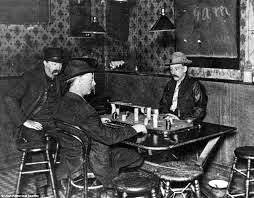 Men who came out west gambled everything on the hopes of becoming prosperous and having a good life. That same spirit led them into gambling halls, and games of chance. One such game started on June 15, 1853 and ended 24 years later.
Men who came out west gambled everything on the hopes of becoming prosperous and having a good life. That same spirit led them into gambling halls, and games of chance. One such game started on June 15, 1853 and ended 24 years later.
For people of the Old West gambling was a way of life. They risked their life by going into Indian Territory for furs, precious metal or land. They staked everything they owned on a herd of cattle being driven north. And for sure they enjoyed a game of chance.
There was faro, euchre, monte, casino, and, of course, poker…which, incidentally, was always dealt to the left of the player to make it easier to pull a gun with the right hand in case of irregularities. The origin of most games of chance came from Europe, with the exception of the old three walnuts and a pea, which started in America, probably on the streets of New York, where it still prospers.
Not only did cowboys loose their wages, but whole herds of cattle, and a cattleman’s entire wealth would change hands over night. A few wives were even offered to “match the pot.”
On June 15, 1853, in Austin, Texas Major Danelson and Mr. Morgan sat down to play poker, and evidentially with little to go home to, forgot to quit. The game went on for a week… then a month… a year became years. The Civil War broke out, was fought and lost, but these two Texas gentlemen still dealt the cards. Finally in 1872, 19 years after it started, both men died on the same day…but the game continued. Their two sons took over, and played for 5 more years.
Finally the game ended in 1877 when a railroad train killed one of the sons, and the other went crazy. Not that all of them weren’t crazy in the first place.
June 17, 2015 | Categories: Old West Myth & Fact | Leave A Comment »
No one noticed a group of men who rode into Liberty, Missouri on February 13, 1866. But, a short while later, when they rode out, everyone noticed them, because they had just done what no one had ever done before.
It was Febr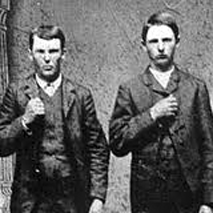 uary of 1866. The Civil War was over. Supposedly, Jessie James was at his mother’s home in Kearney, Missouri recovering from a war wound, and his brother Frank was spending his time with Jessie reading books.
uary of 1866. The Civil War was over. Supposedly, Jessie James was at his mother’s home in Kearney, Missouri recovering from a war wound, and his brother Frank was spending his time with Jessie reading books.
About ten miles away, on February 13, Valentine’s Day, a dozen men rode into Liberty, Missouri. They wore long military coats. It was a cold day, and the streets were deserted. Three men dismounted and took casual positions on the street. The others rode up to the Clay County Savings Association. Two went inside.
A clerk and cashier were inside. One of the men in long coats walked up to the clerk and asked him to change a ten dollar bill. The long coated man then pulled his pistol, and casually asked for all the money in the bank.
These men were doing something that had never been done before…holding up a bank during operating hours. A gain sack was filled with gold and silver coins, paper money and securities totaling $60,000.
After the robbery, the men mounted their horses, and riding at full gallop, whooped, and shot their way out of town. Unfortunately, a 19-year-old college student, George Wymore, was walking down the street. One rider fired at him four times, and Wymore fell dead. A later examination of Wymore discovered that any one of the four shots would have killed him.
In spite of their alibis, this first bank robbery was led by the two James boys from nearby Kearney. Over the next few years they robbed at least twelve other banks, more than a handful of trains, almost a handful of stagecoaches, and even a county fair.
February 13, 2014 | Categories: Old West Myth & Fact | Leave A Comment »
We all think of Doc Holliday as a deadly shootist, killing scores of men. But, in this case our thinking is wrong. In reality, it can only be verified that Doc killed two men…One of them on this date back in 1879.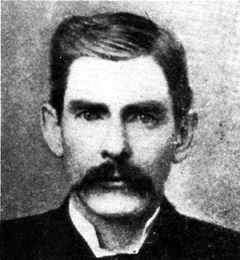
Doc Holliday was a partner in a saloon in Las Vegas, New Mexico. A former army scout named Mike Gordon tried to persuade one of Holliday’s saloon girls to quit her job and run away with him. When she refused, Gordon became upset, and he went out to the street and began to fire bullets into the saloon. After the second shot, Holliday calmly stepped out of the saloon and dropped Gordon with a single shot. Gordon died the next day.
Incidentally, the second killing took place the following year. You may have heard about it. It’s was during the OK Corral Shootout.
July 19, 2012 | Categories: Old West Myth & Fact, Uncategorized | Leave A Comment »
Here’s another Old West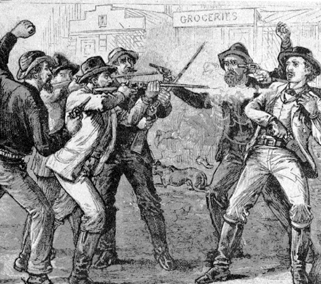 Myth and Fact. Tradition and the early Colt Pistol manuals says to load only five cartridges in a pistol and leave the empty cylinder under the hammer. The reason being if the hammer is accidently hit with a live cartridge under it, it could go off…Incidentally; modern pistols have a safety bar to prevent accidental firing.
Myth and Fact. Tradition and the early Colt Pistol manuals says to load only five cartridges in a pistol and leave the empty cylinder under the hammer. The reason being if the hammer is accidently hit with a live cartridge under it, it could go off…Incidentally; modern pistols have a safety bar to prevent accidental firing.
So, did they load only five cartridges? Not always. Wyatt Earp’s pistol fell to the floor in a saloon and it went off. Lawman Dallas Stoudenmire was being interviewed by a newspaper reporter. During the interview Dallas showed his shooting skills. The reporter said all six shots hit the target. A couple of years ago we published an article in Chronicle of the Old West from 1898 where two men went into the back room of a saloon, and while there a pistol was fired. The people in the saloon though it was a gun fight. Actually, one of the men dropped their pistol.
My feeling is if you were an average Joe you probably loaded five cartridges, but if there was a chance of gunplay you wanted as much firepower as possible. And that extra cartridge could mean the difference between life and death.
What do you think?
May 9, 2012 | Categories: Old West Myth & Fact | 4 Comments »
We’re going to add another element to the posts on Cowboy to Cowboy. And that is “Old West Myth and Fact.” As with anything that has happened in the past, even my exploits, when time gets between the event and the present, a lot of myth begins t o surround the fact. And this is very true with the Old West.
o surround the fact. And this is very true with the Old West.
So, we’re going to look at things that we accept as fact and see if it truly was fact. We’re asking you to put in your two cents, because we could be wrong. The desire is to discover the truth about how it really happened.
The first topic we’ll cover is cowboys and pistols. From everything I’ve been able to discover cowboys normally didn’t carry pistols. First, anytime they were working cattle, the pistol would get in the way. On a cattle drive a long gun was much more practical. Any pistols stayed in the chuck wagon.
Many a cowboy never buckled on a six-shooter because gunmen normally never bothered a man without a gun, and a man without a gun sure wasn’t going to bother a man with one.
In addition, most western towns wouldn’t allow guns to be carried within the city limits.
What do you say?
April 25, 2012 | Categories: Old West Myth & Fact | 6 Comments »
 One of his deputies was a man named Jim Miller. Miller is considered by some historians to be the deadliest gunman of the Old West. He was a dapper little man who was quiet and never cussed. Yet he usually operated as a hired gun killing nameless men who were buried in unmarked graves.
One of his deputies was a man named Jim Miller. Miller is considered by some historians to be the deadliest gunman of the Old West. He was a dapper little man who was quiet and never cussed. Yet he usually operated as a hired gun killing nameless men who were buried in unmarked graves. Two years later the two men met a third time. This time Jim Miller got off the first shot… a shotgun blast to Bud Frazer’s face. I guess Miller was concerned that Frazer might have started wearing a breastplate.
Two years later the two men met a third time. This time Jim Miller got off the first shot… a shotgun blast to Bud Frazer’s face. I guess Miller was concerned that Frazer might have started wearing a breastplate.
 Six months after a member of his own gang shot Jesse James in the back, and after committing at least twenty robberies, on October 5, 1882, Frank James, Jesse’s brother surrendered to Missouri governor Thomas Crittenden.
Six months after a member of his own gang shot Jesse James in the back, and after committing at least twenty robberies, on October 5, 1882, Frank James, Jesse’s brother surrendered to Missouri governor Thomas Crittenden. Governor Crittenden had replied that he could not give amnesty… but if Frank James went on trial and was convicted, he could give him a pardon.
Governor Crittenden had replied that he could not give amnesty… but if Frank James went on trial and was convicted, he could give him a pardon.
 In 1874, Jesse and Frank James were robbing banks and trains to the point that the railroads decided to hire the famous detective group the Pinkertons to hunt them down. But, the Pinkertons, in spite of their numbers and skill, weren’t having any luck rounding up the James boys. Then late in 1874 one of their agents, John Wicher was found dead close to the James home. The Pinkertons were convinced that the James’ or one of their people had killed him, and they decided to raise the ante.
In 1874, Jesse and Frank James were robbing banks and trains to the point that the railroads decided to hire the famous detective group the Pinkertons to hunt them down. But, the Pinkertons, in spite of their numbers and skill, weren’t having any luck rounding up the James boys. Then late in 1874 one of their agents, John Wicher was found dead close to the James home. The Pinkertons were convinced that the James’ or one of their people had killed him, and they decided to raise the ante.










 Born in England, Alice Ivers was educated in a female seminary. She came to the United States and eventually settled down in Colorado where she married Frank Duffield, a mining engineer.
Born in England, Alice Ivers was educated in a female seminary. She came to the United States and eventually settled down in Colorado where she married Frank Duffield, a mining engineer.

 Men who came out west gambled everything on the hopes of becoming prosperous and having a good life. That same spirit led them into gambling halls, and games of chance. One such game started on June 15, 1853 and ended 24 years later.
Men who came out west gambled everything on the hopes of becoming prosperous and having a good life. That same spirit led them into gambling halls, and games of chance. One such game started on June 15, 1853 and ended 24 years later. uary of 1866. The Civil War was over. Supposedly, Jessie James was at his mother’s home in Kearney, Missouri recovering from a war wound, and his brother Frank was spending his time with Jessie reading books.
uary of 1866. The Civil War was over. Supposedly, Jessie James was at his mother’s home in Kearney, Missouri recovering from a war wound, and his brother Frank was spending his time with Jessie reading books.
 Myth and Fact. Tradition and the early Colt Pistol manuals says to load only five cartridges in a pistol and leave the empty cylinder under the hammer. The reason being if the hammer is accidently hit with a live cartridge under it, it could go off…Incidentally; modern pistols have a safety bar to prevent accidental firing.
Myth and Fact. Tradition and the early Colt Pistol manuals says to load only five cartridges in a pistol and leave the empty cylinder under the hammer. The reason being if the hammer is accidently hit with a live cartridge under it, it could go off…Incidentally; modern pistols have a safety bar to prevent accidental firing. o surround the fact. And this is very true with the Old West.
o surround the fact. And this is very true with the Old West.

